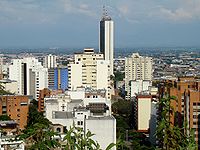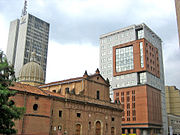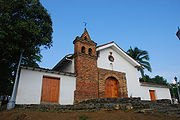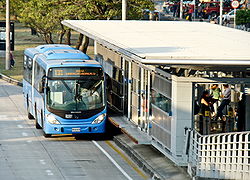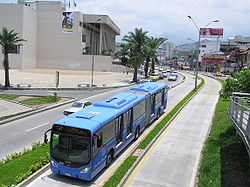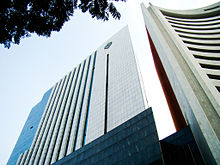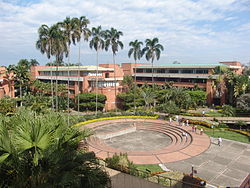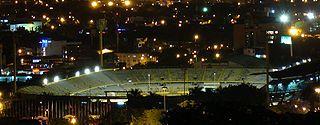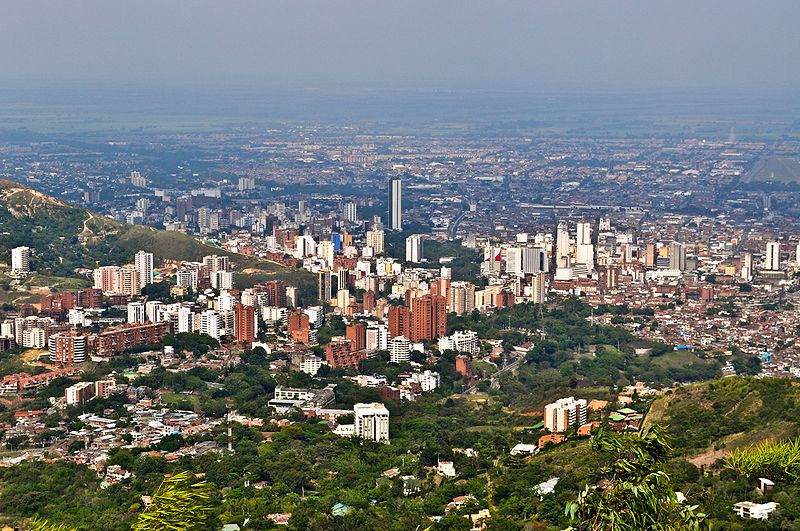- Cali
-
For other uses, see Cali (disambiguation).
Cali — City — Santiago de Cali 
Flag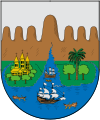
SealNickname(s): "Branch of Heaven", "Sultana del Valle", "Sports City of Colombia", "Cali es Cali, lo demás es loma", "The Salsa´s capital of the world Location of the municipality and city of Cali in the Valle del Cauca Department. Location in Colombia Coordinates: 3°25′14″N 76°31′20″W / 3.42056°N 76.52222°WCoordinates: 3°25′14″N 76°31′20″W / 3.42056°N 76.52222°W Country Colombia Department Valle del Cauca Foundation 25 July 1536 Founder Sebastián de Belalcázar Government – Mayor Jorge Ivan Ospina Area – City 564 km2 (217.8 sq mi) Elevation 997 m (3,271 ft) Population (2005)[1] – City 2,244,158 – Rank Ranked 3rd – Density 3,979/km2 (10,305.6/sq mi) – Metro 2,825,105 Demonym Caleño Time zone COT (UTC-5) Area code(s) 2 HDI (2008) 0.80 – high Website www.cali.gov.co Santiago de Cali (Spanish pronunciation: [sanˈtjaɣo ðe ˈkali]), simply referred to as Cali, is a city in western Colombia and the capital of the Valle del Cauca Department. With a population of 2.5 million, Cali is the third largest city in the country. It has one of the fastest growing economies and infrastructure in the country because of its geographical location. The city was founded on 25 July 1536 by the Spanish conquistador Sebastián de Belalcázar.
Contents
Etymology
Cali is the shortened form of the official name of the city Santiago de Cali. The first part of the full name honours Saint James the apostle (Santiago in Spanish) whose feast day is celebrated on 25 July. The origin of the word "Cali" comes from the local native Indian tribe the "Calima" or "Calimas" descendants of the "Chibcha" tribe. Others believe that the word "Cali" has Quechua origin, and it was brought by the Yanaconas Indians that came from Quito serving Sebastián de Belalcázar. This theory is related to the fact that near Quito there is an indigenous town named Calacali.
History
 Calima's Sculpture
Calima's Sculpture
Pre-Colombian era and conquest
Before the arrival of the Spaniards, the current region of Cali was inhabited by many indigenous tribes, mostly speakers of Cariban languages. In the region between the Cauca River and the Western Cordillera, the Gorrones were established between the present day Roldanillo and Cali. The biggest town of the Morrones was sited on the River Pescador near present-day towns of Zarzal and Bugalagrande. Although cannibals, the Morrones traded with the Quimbayas who inhabited the north of the Valle del Cauca.
On his way to Cali, Sebastián de Belalcázar first met the Timbas who ran away before the arrival of the Conqueror's men, leaving behind their towns and gold. After the Timbas, towards the north, the Spaniards entered the territory of the chief Jamundí and his tribe, the Jamundíes, between the rivers Pance and Jamundí. These Indians offered a strong resistance to the invaders, fighting with poisonous darts and arrows against the arquebuses and swords of the Spaniards. After taking Jamundíes' town the Spaniards looted the Indians' gold.
Before taking complete control over the region, the Spaniards had to defeat the chief Petecuy, whose tribe inhabited the area between the river Lilí and the Western Cordillera. Petecuy formed a big army with many tribes and fought the Spaniards on Holy Tuesday of 1536.
The Morrones gave up easily to the Spaniards and were divided in encomiendas. The already "mestizo" nature of the Spaniards made the process of mixing with the Amerindians easy. In fact, Belalcázar himself fathered several children born in the Americas from Indian mothers, as did his men.
Cali was important for Belalcázar because it was beyond the Inca empire. After the capture and execution of the Inca Atahualpa at Cajamarca, Francisco Pizarro had sent Belalcázar to take possession of Guayaquil and Quito on his behalf, but Cali, being beyond the Quechua empire, was claimed by Belalcazar as his own territory. After his death, his descendants maintained possession of much of the land until the war of independence against Spain.
Founding and colonial period
The founder of Cali, Sebastián de Belalcázar, came to the American continent in the third voyage made by Columbus in 1498. In 1532, after serving in Darién and Nicaragua, he joined Francisco Pizarro in the conquest of Perú. In 1534 Belalcázar separated from Pizarro's expedition to find the city of Quito, and later in his search of El Dorado he entered the territory of what is now Colombia, founding the cities of Pasto and Popayán.
On 25 July 1536, Belalcázar founded Santiago de Cali, first established a few miles north of the present location, near what are now the towns of Vijes and Riofrio. Under the orders of Belalcázar, captain Miguel Muñoz moved the city to its present location in 1537, where the chaplain Brother Santos de Añasco celebrated a mass in the place occupied by the Church La Merced today, and Belalcázar designated Pedro de Ayala as the first municipal authority.
During the Colonia (colonial period), Santiago de Cali was part of the gobernación of Popayán, which was part of Quito's Audiencia. Although initially Cali was the capital of Popayán's Gobernación, in 1540 Belalcázar moved this function to Popayán due to better weather.
Until the 18th century most of the territory of what is now Cali was occupied by haciendas (cattle farms and plantations of food, with some sugar cane), and the city was only a small town near the Cali River. In 1793, Cali had 6,548 inhabitants, 1,106 of whom were (African) slaves. The haciendas were the property of the dominant noble class with many slaves dedicated mostly to stockbreeding and raising sugar cane crops. Many of these haciendas became neighborhoods of the present city like Cañaveralejo, Chipichape, Pasoancho, Arroyohondo, Cañasgordas, Limonar, and Meléndez. Cali was strategically positioned for trade, centrally located in relation to the mining regions of Antioquia, Chocó, and Popayán. In the colonial period, the first trail for mules and horses between Cali and the port of Buenaventura was completed.
Independence
On 3 July 1810 Santiago de Cali refused to recognize the Council of Regency of Spain and established its own junta. This local uprising predates the national one in Bogotá by 17 days.[2] The Governor of Popayán, Miguel Tacón y Rosique, organized an army to control the uprising. The people from Cali called for help to the "Junta Suprema" in Bogotá, which sent a contingent under colonel Antonio Baraya to support the independence cause. For mutual defense, Cali also formed, with Anserma, Cartago, Toro, Buga and Caloto, the "Friend Cities of the Cauca Valley", also known as Confederated cities of the Cauca Valley, which declared independence from the Governorate of Popayán on 1 February 1811, although they continued to recognize the absent Ferdinand VII as their head of state. On 28 March 1811 in the battle of Bajo Palacé the Army of Baraya defeated the royalist army with the help of Atanasio Girardot.[3]
In the following years there were many battles between royalists and local militia. After having been released from captivity by Napoleon, Ferdinand VII sent a large army under the command of the "Pacificador" (Pacifier) Pablo Morillo who restored royalist rule in the area by 1816.
In 1819 after Simón Bolívar defeated the bulk of the royalist army in the Battle of Boyacá, there were new uprisings in the Valle del Cauca and the Criollos took control permanently. In 1822 Bolívar arrived in Cali. The city was an important military outpost and the region contributed many men to the war of independence that liberated the nations in the south.
Modernism
In the 19th century Santiago de Cali, capital of the Valley of the Cauca River State, was a very quiet community with no more than 20,000 inhabitants. The urban center of the city were in the neighborhoods of Empedrado or Altozano, which were surrounded by La Merced and San Antonio neighborhoods.
The city was surrounded by mango plantations, pastures and communal lands that were transferred from the Spanish Crown to the impoverished class. From the market gardens on these lends the city was supplied in food resources. The economy was based mainly on livestock, sugar cane, beef, panela (jaggery), a sugar derivative, cheese and the gold mines from the Pacific; there was also a small growing industrialization sector of the economy.
Around 1890 a private company, Company of Public Works of Cauca, built the Plaza de mercado (market plaza). This originates the development of a commercial area and from this becomes the transformation of the Plaza Mayor or plaza de Caycedo. In 1921, the market was sold to the Cali municipality, very close to the 9th street, were located the principal station of the tranvia of Cali, this system linked the city with suburban areas.
Recent history
On 7 August 1956, at around 1 a.m., seven Colombian army trucks filled with 42 tons of dynamite exploded near the train station, destroying around eight city blocks.[4][5] A nearby army barracks was instantly destroyed, killing all 500 soldiers. Windows were shattered for miles. More than 1,000 people were killed and several thousand injured.[6]
In the year 1971 Santiago de Cali hosted the Pan American Games, an event which is considered by many as the height of the city's golden age as a model of civic orderliness: after it Cali was named the Sports Capital of Colombia. In 1982, the government of Cali inaugurated what is now the third largest building in the Republic of Colombia. "La Torre de Cali", or The Cali Tower. It has a hotel, offices and apartment complexes. It stands at 42 floors above the city, making it the 3rd largest building in Colombia and the largest building in Cali.
Geography and climate
Location
Cali is located on the Cauca Valley to the west of the Cauca River and to the east of the Western Mountain Range near the hills known as Farallones de Cali. The city rests approximately 1,000 meters (3,280 ft.) above sea level and its topography is fairly flat. Approximately 100 km west of Cali and over the Western Cordillera, lies the port city of Buenaventura on the Colombian Pacific coast; to the northeast are the industrial town of Yumbo and the city of Palmira, where Cali's international airport, the Alfonso Bonilla Aragón (CLO), is located in Palmira, Colombia. It is Colombia's third largest airport in terms of passengers, transporting 2,667,526 in 2009.
Geography
Santiago de Cali is located in a valley. The city is completely bordered by mountains to the West, Farallones de Cali are the closest to the city. The Eastern part of the city is bordered by the Cauca river, North and South both are extended plains, in the first one you can find the industrial city of Yumbo part of Cali's metropolitan area, to the south you can find Jamundí, also part of the metropolitan area. The city is mainly flat, but there are areas mostly to the West that are Mountainous, like San Antonio and La loma de la Cruz, both are tourist sites. There are Several rivers that descend from the Western Mountain Range and empty into the Cauca River those rivers pass through the metropolitan area of Cali. In the western part of the city the Aguacatal River flows into the Cali River, which continues on to the Cauca River. In the south the rivers Cañaveralejo, Lilí, and Meléndez flow into the CVC south channel which also empties into the Cauca River. Farther south, the banks of the Pance River are a popular place for recreation and leisure.
Climate
Under Koppen's climate classification, Cali features a tropical savanna climate. The local climate is semi-tropical as the Western Mountain Range screens the flow of humidity from the Pacific coast towards the interior of the country. In the afternoons Cali enjoys a fresh cross breeze that originates in the west and blows east. The Western Mountain Range rises from an average of 2,000 meters above sea level in the northern part of the city to approximately 4,000 meters to the south. Because of this variation in altitude, the weather in the northwest portion of the city is drier than in the southwest. The average annual precipitation varies between 900 mm to 1,800 mm depending on the metropolitan zone for a citywide average of approximately 1,000 mm. Cali's average temperature is 24 °C (75 °F) with an average low temperature of 19 °C (66 °F) and a high of 30 °C (86 °F).
Due to its proximity to the equator there are no major seasonal variations. However, locals refer to the dry season as the city's "summer" period and call the rainy season "winter." There are typically two rainy seasons: from April to May and from October to November. Regardless, rain can be expected to fall at any point during the year nourishing the city's permanent green and lush vegetation.
Climate data for Santiago de Cali Month Jan Feb Mar Apr May Jun Jul Aug Sep Oct Nov Dec Year Record high °C (°F) 37
(98)37
(98)36
(96)36
(96)36
(97)36
(96)36
(96)36
(97)34
(94)34
(94)34
(94)36
(97)35
(95)Average high °C (°F) 30
(86)31
(87)31
(88)31
(88)30
(86)29
(85)29
(85)29
(85)30
(86)30
(86)30
(86)30
(86){{{year high C}}}
(86)Average low °C (°F) 19
(67)19
(67)19
(67)19
(67)20
(68)20
(68)19
(67)19
(67)18
(65)18
(65)19
(67)19
(67){{{year low C}}}
(67)Record low °C (°F) 14
(57)13
(55)14
(57)14
(57)12
(54)12
(54)13
(55)13
(55)12
(53)12
(54)12
(54)13
(55)13
(55)Precipitation mm (inches) 48
(1.89)61
(2.4)103
(4.06)123
(4.84)97
(3.82)65
(2.56)28
(1.1)46
(1.81)69
(2.72)115
(4.53)99
(3.9)65
(2.56)908
(35.75)Source: [7] Tourism
Historic district
Santiago de Cali offers historical areas with cultural variety and other attractions. In downtown Cali, there can be found many historical churches like La Merced and La Ermita. Cali contains a well preserved historical center, the most important zone is La plaza de Caicedo, considered the center of the city, which is a square surrounded by many historical and modern buildings like El edificio Otero, La Catedral and El Palacio de Justicia; This plaza is close to other touristic places, like The Saint Francis church (in Spanish, Iglesia de San Francisco), the municipal theater and La Merced church. The city is also rich in monuments, parks, squares and museums. The most emblematic sculptures are Cristo Rey, located upon a mountain range; Sebastian de Belalcazar, founder of the city; and Las tres Cruces, a place of pilgrimage during the days of the Holy Week.
Regular tourism
There is a variety of nightclubs and restaurants. In the city you can find whole districts dedicated to tourism, for example Granada, one of the most traditional districts in Cali, full of gourmet restaurants, fashion stores and boutiques. Another spot to visit is along "La sexta" or the 6th street and Mbenga which has risen to be the most popular area for clubbing. Many types of nightclubs are there, as are restaurants and hotels. This area is usually called the "zona rosa" or pink zone, and is located in the north very close to Chipichape mall. In the recent years, the restaurant industry has boomed, ranking Cali very close to Bogotá in first-class restaurant options.[citation needed]
Main touristic centers:
- Plaza de Caicedo: The main square of the city, located in downtown Cali. The plaza is named after Cali's hero, Joaquin de Caicedo y Cuero.
- Parque del perro: Located in the San Fernando neighborhood, this is one of the most popular areas in the city, full of restaurants and bars. If you want to party or just have a nice dinner, then this is the place for you. The park gets its name because it has a dog monument in the middle of it.
- Sebastian de Belalcazar's monument: It is the most visited and popular monument in the city[citation needed] located in the hills overlooking the city. The monument is famous due to its pointing finger which is point to the opposite direction of the valley, while its face is looking down at the city.
- Cali River: One of the most peaceful[citation needed] zones in the city, the river is located in the west and is surrounded by restaurants, hotels and museums like "La Tertulia", an art museum.
- Cristo Rey: A religious monument located on a hill that offers the best view of the city. It is 31 m high, from which 5 m belong to the basis.[8][9]
- San Antonio: It is the most traditional neighborhood of Cali. In the colonial age, it was the extension of the downtown. Although it was split off by 'La calle Quinta' (Fifth street), it conserves its traditional aura which makes a inevitable step on the visit. All the neighborhood is on a hill, and at the top you will find the San Antonio Park.
- Juanchito: Although many would prefer to keep it away of the list, Juanchito has made fame. This zone of Cali (which actually belongs to another municipality) might have had the largest number of discothèques and clubs of the country. It all started on the sixties, when Salsa began winning caleños hearts. Some did not like the idea of insinuating dances, but for the majority it became a cult. And Juanchito their temple. To get there, caleños must pass a bridge over the Cauca river. A simple action (?) that has been immortalized by the music, Salsa of course.
- Cali Zoo: Ranked in top 5 of Latin American zoos.[citation needed] It has became most than a place where to show animals, it makes research and has some formations. Its location could not be more wonderful, alongside the Cali river, just where valley and mountains get together. Nearby is the Cali Botanical Garden/ Jardín Botánico de Cali, founded by Jorge Enrique Orejuela.
- Farallones de Cali: A part of the city seats on hills belonging to the Colombian western chain mountain. Beyond these hills there is a full new world,[citation needed][unbalanced opinion] which is protected by the Colombian government. It is the Farallones de Cali national park. Although Caleños have not yet fully discovered it, in the recent years it has boomed[citation needed] as a touristic destination for a full range of different people; adventurists to escalate, walk, paragliding; naturists for its natural and life environments; or simply for those looking for 'cold' weather minutes away of urban areas.
- La Ceiba: A large and old Ceiba tree on a street corner at the west of the city.[10]
- Orquideorama Enrique Perez Arbelaer: This lovely, wooded park, at AV 2 N #48-10, is the site of the large orchid show hosted each fall by Asociacion Vallecaucana de Orquideologia. In 2011, the show will be held 21–25 September and will include international judging by the American Orchid Society. It is also a good place for birdwatching.
Just walking could not mean a lot, but calenos love doing it in the late afternoon. After 4 pm, when heat goes down, breeze starts. It comes from the neighboring mountains, and refreshes souls[unbalanced opinion] and bodies.
It is normal in Cali to think of a shopping mall as a touristic place. Most of them are built like urban boulevards, with open-air walking corridors that look like a 'Main Street' side walk. With large facilities providing full amenities, Caleños love just talking walks in them, enjoying the fact[unbalanced opinion] that everything is at their hands. The most traditional malls[citation needed] are Unicentro at south and Chipichape at North; both built in the open-air style. Others of this type are Palmetto Plaza, Jardin Plaza and Cosmocentro. Other malls in Cali are Centenario, Unico and La14. Tens of smaller malls are spread all over the city. Certainly,[unbalanced opinion] bargains will not be found on most of these malls. Downtown's 13th, 14th and 15th streets are the bargains' hub of the city. In the 'San Andresito' or 'Pasaje Cali' malls (or any of that kind in the area) you can buy thousands of inexpensive China-made products. Street-selling is legal in only certain locations. There you could find one-of-a-kind crafts.[citation needed]
Medical Tourism
According to recent Lonely Planet[11] guides of Colombia, Cali has recently become famous for being a prime destination for people seeking cheap cosmetic surgery. Cali's surgeons are famous in Colombia for having shaped some of the country's most beautiful women. There have been no significant reports of problems in this area, but Lonely Planet advises proper research before pursuing such an idea.
Transportation
Airports
Santiago de Cali is served by Alfonso Bonilla Aragón International Airport (IATA: CLO, ICAO: SKCL), located in the City of Palmira. It is Colombia's third largest airport in terms of passengers transporting (3,422,919 in 2010) and 4th in cargo. Alfonso Bonilla Aragón is located in a long, narrow valley that runs from north to south, and is surrounded by mountains up to 14,000 feet (4,000 m) high. The airport is connected to the city by a highway known as the "recta a Palmira", that in the last few years has been upgraded to make it a more accessible airport to Cali and the surrounding city centers in the region. The airport has also has been remodeled recently, some of the last significant events in those terms were the inauguration of the VIP room in the National terminal and the installation of a main electronic screen in the center of the check-in area. As for any international airport, you can find different services and facilities :
- Car rental : AVIS (+572 4860900) and other international companies.
- Hotel
- Restaurants, Coffees and bars : Some typical of Cali and Colombia
- Handicrafts stores
- Duty Free-Paid
- Travel Agencies
- Financial services (Locals) and Currency exchanges
- Telecommunication services
- Beauty Salon
- Nail Salon
There is a military airport close to the city's downtown. The Marco Fidel Suarez Military Air Base is located in the east side of the city and belongs to the Colombian Air Force. It is used as one of the main training centers for the country's Fighter pilots.
Public transportation
The city of Cali offers a variety of ways to move through the city; in March 2009, The Masivo Integrado de Occidente (MIO) began operations. It is planned to be the primary system that connects the city. Taxis and old buses are the secondary way to get around. Taxis are one of the best systems that tourists can use, as they are relatively inexpensive and are the most secure of the two. Non-MIO buses round-out the system and are used primarily by the working class to get around and are the least expensive to use. Buses are secure but not at the same level as taxis. This part of the transport in the city is waiting a needed reorganization of routes.
Masivo Integrado de Occidente (MIO): A massive transit system; M.I.O is based on the transportation model that consist in the use of articulated buses that runs through dedicated bus lanes running down the middle of major thoroughfares. MIO bus stations are locate in the middle of the thoroughfare, and are connected with sidewalks by dedicated pedestrian crossings or bridges. The system layout is 243 kilometers and is distributed in a main trunk, pre-trunk and complementary corridors. The system also integrated the renovation and recuperation of the public space. The MIO system was not only designed for the public transport, but built for public use with extensive new sidewalks, parks, gardens and public squares for the public to enjoy.
List of the Trunk or principal corridors:
- Calle 5
- Carrera 15
- Calles 13 y 15
- Avenida de las Américas
- Avenida 3N
- Carrera 1
- Transversal 25
- Carrera 29 y Autopista Oriental
- Calle 70
More information about El MIO, in the official web site of Metrocali.
Bus Central Station
Cali is served by over 20 coach companies[12] which gather in the Bus Central Station. The Station is centrally located nearby to the old-idle train station, which serves now as Metrocali's headquarters. Depending on the company and the destination, the vehicles range from minibuses to large coaches. Recently, in their last float renovation wave, Colombian coaches operators have opted for Brazil's Marcopolo buses. Informal stops exists for the short destination rides all alongside the way from Central Station to the town of destination. In some cases, it is enough for a passenger to ask to get off the bus for the bus to stop.
Driving directions
- Bogotá-Cali: Distance between Cali and Bogotá is about 440 km.[13] From Bogotá you must take route 40 South. This route passes through Melgar, Girardot, Ibague, and Armenia. About 50 km after have passed Armenia, take the Route 25 South for another 120 km. (Takes about 10 hours).
- Cali-Medellín : Distance between Cali and Medellín is about 460 km.[13] From Cali you must take Route 25 North. This Route passes through Palmira, Tulua, Buga and Cartago in the department of Valle del Cauca. And through La Pintada and Itagüí in the department of Antioquia.
- Cali-Quito: Distance between Cali and Quito is about 600 km. From Cali you must take Colombian National Route 25 South. This route passes through Popayán, Pasto and Ipiales, which is the border city in the Colombian side. In Tulcan (border city in Ecuador) you start Ecuadorean Route 35 South. You drive about 190 km before reaching Ecuadorean Route 28 West.
Route 25 is the main North-South route in Colombia, so for other destinations further than Medellín or Bogotá, you certainly must pass through this cities. With the exception of Buenaventura, for most destinations in the department of Valle del Cauca you must take this route as well.
Economy
Cali and the department (province) of Valle del Cauca (Valley of the Cauca River) conform one of the principal commercial centers in Colombia. The city is a national and international point of exchange. Cali has a privileged geographical location due to its proximity to the port-city of Buenaventura which is Colombian main port on the Pacific ocean. The city's economy is preceded and established mostly by its history reflected in the many sugar plantations on the area, which are part of the legacy of the haciendas(plantations). Industrial development is remarkable for the regional economy; the north part of the city is the most industrialized district. The city of Yumbo, a northern suburb of the metro area, is a major industrial hub for many corporations, such as Colombia's beverage producer Postobón S.A. and Bavaria a SABMiller brewery, among others.
Since 1940, Valle del Cauca's PIB has grown at twice the average rate of the country, according to DANE statistics. In 1997 the regional GDP growth rate slowed, not even reaching 1%. In 1999 countrywide recession affected specially the regional economy, and GDP decreased −4% annually. Since then the economy has behaved erratically.
Economy 2006–2011 Between 2006 and 2011 the economy of Cali has continued to be 'highly dependent' on textiles and cultivation of sugar, according to several reports.[14]
Crime
Further information: Crime in ColombiaCrime is a serious problem in Cali. As of 2006, there were 1,540 intentional homicides in the city and 1,726 overall when including the metropolitan area. The rates for the city and metropolitan area were 62 and 63 per 100,000 respectively. By 2011 this has increased to 71 homicides per 100,000 inhabitants, which has lead certain commentators to declare a 'crisis of security' in Cali.[15][16]
Between 1 January and 1 June 2011 there were 923[17] intentional homicides in the inner city of Cali, which is considered a 5% increase compared to 2010.[18] The surge in violence in Cali in 2011 has partly been attributed to what has been described as an ongoing 'mafia war' between the 'neo-paramilitary' groups Los Rastrojos and Los Urabeños.[19] Los Rastrojos are considered the 'heirs' of the Cali Cartel and Los Urabeños have their roots in Colombia's atlantic coast. Los Rastrojos are accused of committing at least 80 murders in Cali in 2011.[20]
According to Colombia's most influential weekly magazine, Semana, there are over 1,700 assassins working for various groups in the city.[21] As of 2011 urban militias, known as Milicias Populares, of the Revolutionary Armed Forces of Colombia are active in the city and surrounding areas.[22][23] Local civilians and foreigners have been adviced by the DAS to take caution due to the risk of planted bombs and kidnappings.[24]
The metropolitan police and the Colombian Army have taken action to stop several high profile bomb attacks against military and administrative centers in recent years, such as the multiple FARC attacks against Cali's Palace of Justice in 2008 and 2010.[25][26] These FARC militias in the Cali metropolitan area are thought to number more than 1000, and have caused serious concern among the authorities as they have stepped up activity in 2011.[27][28]
In November 2010 the U.S. State Department issued a travel warning regarding Cali, warning of a sharp increase in crime and "terrorist activity".[29]
Politics
Cali is governed by a mayor who is elected for a four-year term. Under the mayor, there are several administrative departments and secretaries. Mayor's elections started in 1986, followed by Governors' in 1992. Before these dates, all Colombian regional executive-branch leaders were appointed by the President himself. The first elected mayor was Carlos Holmes Trujillo of the Liberal Party. Unlike other Colombian cities, Cali has not properly adapted to the quite new Mayor's election system. The city has had some unsuccessful stories with some of its elected mayors, two of them being removed of the office. Some argue this is caused by Aguablanca's huge mass population often driven to vote based in small short-termed gifts from populists candidates fully aware of this District needs. There were recorded cases of candidates giving bricks, cement and other stuff to the District's leaders in exchange of shifting votes to their campaigns.
Elected Mayors of Cali Mayor Started Ended Carlos Holmes Trujillo García January 1988 January 1990 Germán Villegas Villegas January 1990 January 1992 Rodrigo Guerrero Velasco January 1992 December 1994 Mauricio Guzmán Cuevas January 1995 August 1997 Julio César Martínez Payán August 1997 December 1997 Ricardo H. Cobo Lloreda January 1998 December 2000 John Maro Rodríguez Flórez January 2001 December 2003 Apolinar Salcedo Caicedo January 2004 May 2007 Sabas Ramiro Tafur Reyes May 2007 December 2007 Jorge Ivan Ospina January 2008 December 2011 The City Council is composed by 21 members, elected by citywide circumscription for four year terms. There is no relation between the number of City Counselors and the number of 'comunas' of the city, which is a merely administrative division created to facilitate city's management.
Cali has some decentralized agencies; the most important being :
- EMCALI: Energy, telecommunications, aqueduct and sewage systems services. http://www.emcali.com.co/vsmPC/index.php (Spanish)
- Emsirva: Public waste management company for the city of Cali. http://www.emsirva.com.co/ (Spanish)
- Metrocali: http://www.metrocali.gov.co/ (Spanish)
- Calisalud: http://www.calisalud.gov.co/inicio/index.php (Spanish)
- Corfecali: http://www.cali.gov.co/Corfecali.php (Spanish)
- EMRU: http://www.cali.gov.co/Emru.php (Spanish)
2007 Elections
The 2007 elections took place on 28 October 2007 to replace Ramiro Reyes as mayor of Santiago de Cali. Jorge Ivan Ospina, Francisco Lloreda, Bruno Diaz, Diego Luis Hurtado and Jorge Portocarrero were running for the Office. Jorge Ivan Ospina (Left wing running as Independent) was elected Mayor for the 2008–2011 term with 49.05% of votes, followed by Francisco Lloreda (Conservative running as Independent) with 39.02%. Mr Lloreda was at his third attempt to become Mayor of the city, being defeated every time.
Education
A large part of the population relies on the public educational system, which is underfunded and in some cases improperly managed. Schools are under municipal or departmental management, the former being the most common. The Municipal Secretary of Education manages a large part of the city's budget, which has brought some politicians to try to control it as their personal organization.
The city is endowed with the most sophisticated and high-quality secondary education institutions and universities in the region. Most universities are located in the south of the city. Among the most prestigious are University of Valle (Public), Pontificia Universidad Javeriana (Private), and Universidad ICESI (Private).
Universities
- University of Valle. (Public) It is the largest higher education institution by student population in the southwest of the country, and the third in Colombia, with more than 30,320 students.[30][31] Its Faculties of Medicine, Engineering, Sciences, and Social Sciences rank as the best of the region. The first three rank at the top in the national level. Unlike every other Colombian public university, Univalle does not have a Law School.
- Universidad Autónoma de Occidente. (Private) Founded in 1975, this private institution has more than 7,400 students.
- Pontifical Xavierian University. (Private) Founded in 1970, Pontifical Xavierian University Seccional Cali serves as the sectional campus of the Pontifical Xavierian University of Bogotá. PUJ (by its Spanish acronym) is a private higher education institution currently with more than 5,700 students enrolled in its seventeen undergraduate and twenty graduate programs offered by its faculties of engineering, economic and administrative sciences, humanistic and social sciences and health sciences. With over 36,000 printed books spanning a wide array of academic topics, the university's library is one of the biggest in the city. Beginning in 2010 the university will inaugurate its Medicine school bringing its total number of undergraduate degrees to seventeen.[32] Pontifical Xavierian University is one of the most prestigious universities in the city of Cali offering first class education through its accredited and award-winning programs.
- Universidad Icesi. (Private) University ICESI was founded in 1979 by regional entrepreneurs looking to solve the lack of highly skilled professionals in the areas relevant to their business. It offers undergraduates programs, specializations and masters. It has more than 2,950 students and a library with over 30,000 books. On the 2nd semester of 2009, the university will start its highly anticipated Medicine School, which will use the Valle del Lily Health Center as its training and educational facility.
- Universidad San Buenaventura. (Private) Founded in 1970 by the Franciscan Order, it's a private institution of higher education that serves like sectional for University of St. Buenaventura of Bogotá.
- Free University of Colombia.
- Universidad Santiago de Cali (Private) The University Santiago de Cali also known as La santiago or USC is a private corporation and institution of higher education founded in 1959
- National Learning Service (SENA).
- Antonio Jose Camacho University Institute (Public)
- Corporación Universitaria Centro Superior (Private)
- Escuela Nacional Del Deporte (Mixed) Founded in 1984, the Escuela Nacional Del Deporte (Sports National School) is, along with Politecnico Jaime Isaza Cadavid (Medellín), the most important institution in Colombia for physical activity, physical therapy and sports science.
- University San Martin
La Manzana del Saber
Located in the south of the city, La Manzana del Saber is today the most important educational project in Cali. There is already a Science Museum and a public library, the project is going to build a new museum called "Abrakadabra" and a investigation center. The project is in construction phase, the demolition of a whole block of the city will be undertaken to build the complex.
You can find more information about this project at www.cali.gov.co. (Spanish)
Arts and culture
Cultural centers
- Casa de la cultura Proartes. Since 1871 this house has been a great influence in the culture in cali. The building was restored on 1991 and it contains exhibition saloons, scenarios and a cinema.
- Centro cultural de Cali. Since 1997 it is considered the cultural center in the city and headquarters of the Municipal secretaries of truism and culture.
Museums
- Museo Arqueológico La Merced
- Museo Religioso y Colonial de San Francísco
- Museo del Oro Calima from the Rebublica bank
- Museo de arte moderno La Tertulia
- Museo Arqueologico de la Universidad del Valle
- Museo Departamental de Ciencias Naturales
- Museo Nacional del Transporte
- Museo de Arte Religioso
Feria de Cali (The Cali Fair)
"La Feria de Cali" is the main cultural event in the city. It is a fair that has been celebrated since 1957. The fair is celebrated from 25 to 30 December. The fair is known also as the "Feria de la Caña" (sugar cane fair) and "Feria de la salsa" (Salsa fair). People enjoy many activities like an opening cabalgata (parade of horseback riders), tascas, salsa concerts, bullfights, parades, athletic activities, competitions and cultural exhibitions.
Cali is also known as the "Capital de la Salsa" given the city's infatuation with that type of Afro-Caribbean music. In early July there is the Summer Salsa Festival which lasts for one week. It usually includes concerts by some of the world's great salsa bands as well as dance shows and "melomano" competitions in which salsa connoisseurs try to out do each other by digging deep into the archives of salsa music and related sounds to find and reveal long lost tunes.[34]
Rio Cali race
Cali has two main athletic events, a mid-year half marathon 1/2 Maraton de Cali and a December 10k race called Carrera del Río Cali.
Sports
At a professional level, Cali hosts just football teams. At the amateur level there are Basketball, Football, Volleyball, and other sports. Nationally, Cali's athletes compete with Bogotá's and Medellín's in most sport tournaments and championships.
Colombia's sports capital city

The city of Santiago de Cali is recognized as the sports capital of Colombia. It is the first Colombian city to have hosted the Pan American Games 1971 Pan Am Games, and because this region has won the National Olympic Games more than any other region in Colombia. The city also counts with one of the most developed sport infrastructures in the country, many sporting events have taken place in the city.
Cali has two football stadiums; Estadio Olímpico Pascual Guerrero and Estadio Deportivo Cali/del Deportivo Cali/Palmaseca. Estadio Olímpico Pascual Guerrero is currently home of both Deportivo Cali and América de Cali, since Estadio Deportivo Cali is still under construction. Deportivo Cali is the only football team owner of a stadium in Colombia since all of the other football stadiums are owned by the government, other important scenario in the city is "El pueblo Arena" is a covered arena center use for all type of events, the main use is basketball.
Infrastructure
Cali's infrastructure has permitted it to host several major international sports competitions such as the 1971 Pan American Games, numerous Games of the Pacific, the final phase of the 1982 World basketball championship, the 1999 World's Roller Hockey Championships, women's basketball and swimming events, Pan American Speed-Track Cycling Championships, and most recently the World's Roller Speed Skating Championships. Cali will host the World Games 2013.
- Pascual Guerrero Olímpic stadium
- El Pueblo Arena
- Polideportivo de El Vallado
- Unidad Deportiva Panamericana
- Velódromo Alcides Nieto Patiño
- Gimnasio Evangelista Mora
- Patinódromo Los Diputados
- Estadio del Deportivo Cali
Football
Santiago de Cali is home of Colombia's Deportivo Cali and América de Cali football clubs. Many well-known football players were either born in Cali or have played in one of its clubs. Wellington Ortiz, Carlos (El Pibe) Valderrama, Anthony (El Pipa) de Avila, Alex Escobar, Julio Cesar Falcioni, Jorge da Silva, Jorge Bermudez, Giovanny Hernandez, Hugo Rodallega, Mario Yepes, Faryd Mondragón, Adolfo (el tren) Valencia, and Oscar Córdoba are a sample of them.
According to Conmebol, América ranks 2nd and Deportivo Cali 3rd[35] in the Colombian national ranking, which ranks itself 3rd in the Conmebol ranking. America was ranked as the world's 2nd best club in 1996 by the IFFHS (International Federation of Football History & Statistics)[36] and 35th in the All-Time Club World Ranking of the IFFHS.[37] Cali is the Colombian city having hosted the most Colombian first division finals, with 40 matches being played in the stadium. America has won 13 titles, and has been second on 7 occasions. Deportivo Cali has won 8 titles, second in 11 occasions. They have played final against each other three times. In the early 50's, now second-division city's team Boca Juniors lost two finals.
Basketball and bullfighting
Though there is no current basketball team that calls Santiago de Cali home, basketball is the second-most played sport in the city. Basketball is a preferred sport at the city center location "La Carrera del Cholado". Football still surpasses basketball in sport popularity. Bullfighting is staged during the Cali Fair which is held in December. It is anticipated by many citizens in Cali, as well as all Colombia. The bullfighting ring is called La Plaza de Toros de Cañaveralejo, located southwest of Cali.
Nicknames
- (Spanish) Capital Mundial de la Salsa or (English) Salsa Capital of the World
Sister cities
 Palos de la Frontera, Spain
Palos de la Frontera, Spain Athens, Greece
Athens, Greece
Other views
Sky view of Southern CaliReferences
- ^ "Presentación de PowerPoint" (PDF). http://www.dane.gov.co/files/censo2005/resultados_am_municipios.pdf. Retrieved 24 June 2010.
- ^ Mendoza Neira, Plinio, ed. Cali: La sultana del Valle (Librería Colombiana Camacho Roldán, 1962).
- ^ Zawadzky C., Alfonso, Comentario al libro Las Ciudades Confederadas del Valle del Cauca en 1811. Bogotá, Editorial Librería Voluntad, S.A., 1943.
- ^ | Museo Nacional de Colombia | Cali, la explosión de 1956: catástrofe histórica
- ^ [1] El País – Cali recuerda la explosión del 7 de agosto[dead link]
- ^ Angela Davis acquitted—History.com This Day in History—6/4/1972 This Day in History: Mysterious Explosions in Colombia
- ^ www.ideam.gov.co
- ^ Monumento a Cristo Rey en Cali (Absolut Colombia)
- ^ Cristo Rey (Alcaldía de Santiago de Cali)
- ^ Piden ayuda para ceiba del Oeste (El País, 27 November 2008)
- ^ Krzysztof Dydynski. "Cali Travel Information and Travel Guide – Colombia". Lonely Planet. http://www.lonelyplanet.com/colombia/southwest-colombia/cali. Retrieved 24 June 2010.
- ^ Bus Station website. List of operating companies (Spanish)
- ^ a b Logired website
- ^ Account Suspended
- ^ Cali: listado de los 20 barrios más violentos en el 2011 : Noticias de Judicial – elpais.com.co
- ^ "Observatorio del Delito Estratega para el control de la violencia urbana" (in Spanish). Universidad del Valle. Archived from the original on 10 June 2007. http://web.archive.org/web/20070610154818/http://www.elpais.com.co/paisonline/especiales/dialogos/docs/rafael.ppt. Retrieved 8 July 2006.
- ^ http://www.elpais.com.co/elpais/judicial/fallece-reconocido-medico-oftalmologo-por-asalto-fleteros-en-sur-cali
- ^ http://www.elpais.com.co/elpais/judicial/lideres-empresariales-y-gremiales-reclaman-politica-seguridad
- ^ Mafia War Feared in Cali, as Rastrojos Face New Competition
- ^ Racha de violencia tiene atemorizado al norte del Valle del Cauca : Noticias de Judicial – elpais.com.co
- ^ http://www.semana.com/nacion/chicago-criolla/157505-3.aspx
- ^ El Espectador http://www.elespectador.com/noticias/judicial/articulo-237365-farc-multiplican-sus-ataques-y-retoman-guerra-de-guerrillas
- ^ Colombia Reports http://colombiareports.com/colombia-news/news/13149-farc-return-to-classic-guerrilla-tactics.html
- ^ Colombia Archived 28 December 2010 at WebCite
- ^ Frustran ataque terrorista de las Farc con volqueta bomba en Cali | Noticias Bogota y Colombia | Emisora Radio Santa Fe 1070 am en vivo
- ^ Un atentado terrorista en el centro de Cali mató a cuatro personas – lanacion.com
- ^ Milicias, el plan pistola en el Cauca – El Colombiano
- ^ En Cali cayó jefe de Las Milicias Bolivarianas de Las Farc en Corinto, Cauca | RCN La Radio – RCN Radio
- ^ U.S State Department. Travel Warning: Colombia, November, 2010. http://travel.state.gov/travel/cis_pa_tw/tw/tw_941.html Archived 28 December 2010 at WebCite
- ^ "Universidad del Valle en cifras – Semestre II, 2008" (in Spanish). http://planeacion.univalle.edu.co/a_gestioninformacion/univalle_cifras/uv-cifras_2008-II_v0.pdf. Retrieved 3 March 2009.[dead link]
- ^ "Estudio comparativo de cuatro Universidades Públicas Colombianas" (in Spanish). http://paginasweb.univalle.edu.co/~planeacion/a_gestioninformacion/sue/SUE_2007_UNIPUB_2003-2006.pdf. Retrieved 21 February 2009.[dead link]
- ^ "Pontificia Universidad Javeriana – Llega Medicina a la Javeriana Cali. Inscripciones abiertas" (in Spanish). http://www.javerianacali.edu.co/Paginas/Facultad/Pregrados/Facultad_de_Ciencias_de_la_Salud/Medicina/Plt_PreMedicina_index.aspx. Retrieved 10 November 2009.
- ^ Museos - Cali's Museums guide
- ^ calideferia.com – cali de feria Resources and Information. Cali fair Guide
- ^ [2][dead link]
- ^ International Federation of football History and Statistics IFFHS
- ^ All-Time Club world Ranking of the IFFHS
External links
(Some of the following links are all in Spanish language)
- Alcaldia de Santiago de Cali (Spanish)
- Cali travel page on Colombia Reports (English)
- Gobernación del Valle del Cauca (Spanish)
- Universidad del Valle (Spanish)
- Universidad Santiago de Cali (Spanish)
- Universidad San Buenaventura (Spanish)
- Universidad Autónoma de Occidente (Spanish)
- Universidad ICESI (Spanish)
- Pontificia Universidad Javeriana – Cali (Spanish)
- El País newspaper (Spanish)
- Occidente free newspaper (Spanish)
- Places to go and Things to do in Cali Colombia (English) (Spanish) (French) (Italian)
- Armatedeplan.com – Todos los eventos en Cali (Spanish)
- (PDF) – 2005 Census data
- (English) Info about Cali – Off 2 Colombia –
Pictures
Municipalities in the Valle del Cauca Department Alcalá • Andalucía • Ansermanuevo • Argelia • Bolívar • Buenaventura • Buga • Bugalagrande • Caicedonia • Cali • Calima • Candelaria • Cartago • Dagua • El Aguila • El Cairo • El Cerrito • El Dovio • Florida • Ginebra • Guacarí • Jamundí • La Cumbre • La Unión • La Victoria • Obando • Palmira • Pradera • Restrepo • Riofrio • Roldanillo • San Pedro • Sevilla • Toro • Trujillo • Tuluá • Ulloa • Versalles • Vijes • Yotoco • Yumbo • ZarzalPan American Games host cities 1951: Buenos Aires • 1955: Mexico City • 1959: Chicago • 1963: São Paulo • 1967: Winnipeg • 1971: Santiago de Cali • 1975: Mexico City • 1979: San Juan • 1983: Caracas • 1987: Indianapolis • 1991: Havana • 1995: Mar del Plata • 1999: Winnipeg • 2003: Santo Domingo • 2007: Rio de Janeiro • 2011: Guadalajara • 2015: Toronto
Categories:- Populated places in the Valle del Cauca Department
- Municipalities of Valle del Cauca
- Populated places established in 1536
- Visitor attractions in Cali
- Capitals of Colombian Departments
Wikimedia Foundation. 2010.







